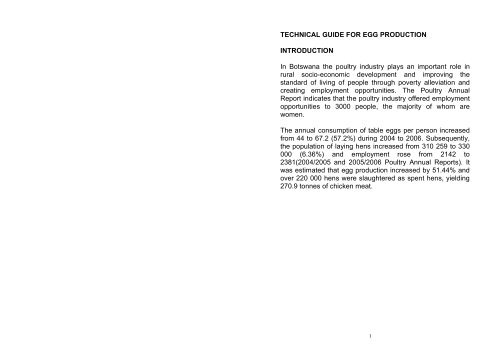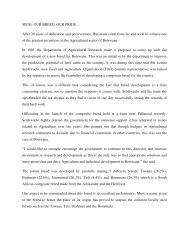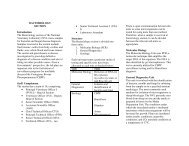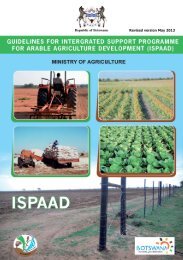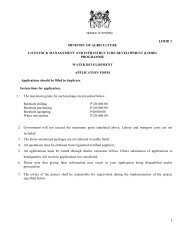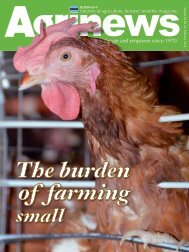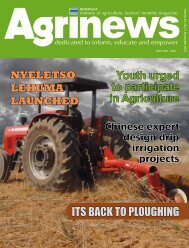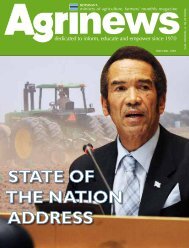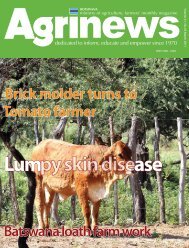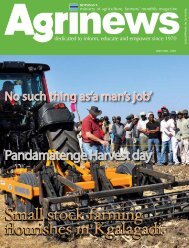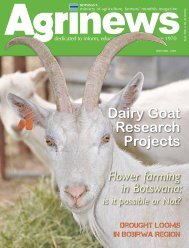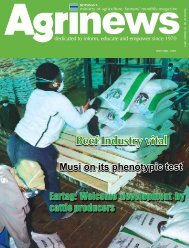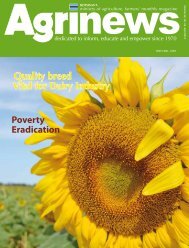TECHNICAL GUIDE FOR EGG PRODUCTION INTRODUCTION In ...
TECHNICAL GUIDE FOR EGG PRODUCTION INTRODUCTION In ...
TECHNICAL GUIDE FOR EGG PRODUCTION INTRODUCTION In ...
Create successful ePaper yourself
Turn your PDF publications into a flip-book with our unique Google optimized e-Paper software.
<strong>TECHNICAL</strong> <strong>GUIDE</strong> <strong>FOR</strong> <strong>EGG</strong> <strong>PRODUCTION</strong><strong>INTRODUCTION</strong><strong>In</strong> Botswana the poultry industry plays an important role inrural socio-economic development and improving thestandard of living of people through poverty alleviation andcreating employment opportunities. The Poultry AnnualReport indicates that the poultry industry offered employmentopportunities to 3000 people, the majority of whom arewomen.The annual consumption of table eggs per person increasedfrom 44 to 67.2 (57.2%) during 2004 to 2006. Subsequently,the population of laying hens increased from 310 259 to 330000 (6.36%) and employment rose from 2142 to2381(2004/2005 and 2005/2006 Poultry Annual Reports). Itwas estimated that egg production increased by 51.44% andover 220 000 hens were slaughtered as spent hens, yielding270.9 tonnes of chicken meat.1
Prerequisites for establishing egg production projectBefore setting up a project, one should have;Land: Adequate land to house poultry structures and forcarrying out various farm operations.Water: Adequate clean water is needed for consumption andcleaning within the poultry project. So it is imperative toidentify a reliable source of portable water.Loan SummaryScheduled Payment P72,861.87Scheduled Number of Payments 7Actual Number of Payments 7Total Early Payments P0.00Total <strong>In</strong>terest P124,112.81Skills and experience: Basic training and experience inpoultry management is essential for running a poultryenterprise.Capital: A source of potential funding for acquiring inputs andequipment needed to run the project. Requirements andpolicies of financial institutions ought to be known prior toloan acquisition.MANAGEMENT PRACTICES<strong>In</strong> egg production, the aim is to produce as many table eggsas possible over the laying life of the hen. The success ordownfall of egg production is determined by the managementpractices used.TotalPayment Principal <strong>In</strong>terestEndingBalanceP72,861.87 P43,917.85 P28,944.02 P342,002.4172,861.87 47,211.69 25,650.18 294,790.7272,861.87 50,752.56 22,109.30 244,038.1672,861.87 54,559.00 18,302.86 189,479.1672,861.87 58,650.93 14,210.94 130,828.2372,861.87 63,049.75 9,812.12 67,778.4867,778.48 62,695.09 5,083.39 0.00LabourThe manager should be experienced and have basic trainingin poultry management. A poultry house whichaccommodates 1000 and 2000 hens will require 1 and 2poultry attendants respectively. Casual labourers will berequired during cleaning and restocking.223
<strong>EGG</strong> <strong>PRODUCTION</strong> PROJECTIONSPmtNo.Enter ValuesLoan Amount P385,920.26Annual <strong>In</strong>terest Rate 7.50 %Loan Period in Years 7Number of Payments Per Year 1Start Date of Loan 1/1/08Optional Extra Payments $ P-Lender Name:PaymentDateCEDABeginningBalanceScheduledPaymentExtraPayment1 1/1/09 P385,920.26 P72,861.87 P0.002 1/1/10 342,002.41 72,861.87 P0.003 1/1/11 294,790.72 72,861.87 P0.004 1/1/12 244,038.16 72,861.87 P0.005 1/1/13 189,479.16 72,861.87 P0.006 1/1/14 130,828.23 72,861.87 P0.007 1/1/15 67,778.48 72,861.87 P0.00Production systemsThere are two main production systems in Botswana. That islaying cage and deep litter systems.a) Laying cage systemHere hens are kept throughout their productive life time incages. However, this system requires high capitalinvestment. As such, they are strictly commendable for useby commercial egg producers. The stocking density dependson the hen’s body size and weight. It is 3 to 5 hens percubicle. That is, the heavier the hens the fewer they would beper cubicle. <strong>In</strong> a laying cage system, hens do not havecontact with droppings which reduces infections. Feeding,providing water, egg collection, removal of litter and cleaningare easier for the poultry attendants to perform.b) Deep litter systemHere hens are confined in a house with floor space of 8 to 10birds/m 2 to ensure free movement. The floor should becovered with a 5cm to 10cm deep litter of grain husks (maizeor rice), straw, wood shavings or a similarly absorbent (butnon-toxic) materials. Wood shavings are highlyrecommended for use since birds cannot eat them.Litter provide insulation from the floor and soaks up moisturefrom the droppings. It also helps to prevent damage to thebirds’ legs due to slippery surfaces. Usually old litter isrenewed when replacement stock arrives. It is advisable notto re-use old litter. After old litter has been removed out of thehouse, the floor should be cleaned and disinfected.This guideline will focus on the laying cage system.223
Laying periodEgg producers buy chicks at point of lay, which is betweenseventeen (17) to eighteen (18) weeks old. At this age, fewhens will start laying eggs immediately.However, at around the 21 st week, majority of the hens willstart laying eggs through to 44 weeks (11months) old afterwhich the flock will be replaced. Should egg-laying start whenhens or pullets are too fat or before they are fully physicallyand sexually mature at 20 weeks or five (5) months of age,the overall performance during the laying period will beaffected resulting in fewer eggs produced.Year 3 Year 4 Year 5 Year 6 Year 7 Year 8 Year 9 Year 10504,570.00 555,027.00 610,529.70 671,582.67 738,740.94 812,615.03 893,876.53 983,264.191,444,070.00 1,999,097.00 2,609,626.70 3,281,209.37 4,019,950.31 4,832,565.34 5,726,441.87 6,709,706.06170,962.57 188,058.83 206,864.71 227,551.19 250,306.30 275,336.93 302,870.63 333,157.6954,559.00 58,650.93 63,049.75 62,695.09 0.00 0.00 0.00 0.00279,048.42 308,317.24 340,615.24 381,336.39 488,434.63 537,278.10 591,005.91 650,106.5019,941.19 19,941.19 19,941.19 19,941.19 19,941.19 19,941.19 19,941.19 19,941.19259,107.23 288,376.05 320,674.05 361,395.20 468,493.44 517,336.91 571,064.72 630,165.3118,302.86 14,210.94 9,812.12 5,083.39 0.00 0.00 0.00 0.00240,804.37 274,165.11 310,861.93 356,311.81 468,493.44 517,336.91 571,064.72 630,165.3136,120.66 41,124.77 46,629.29 53,446.77 70,274.02 77,600.54 85,659.71 94,524.80204,683.71 233,040.35 264,232.64 302,865.04 398,219.43 439,736.37 485,405.01 535,640.51Health and common diseasesDisease prevalence varies from one area to the other. Theproblems that may trigger disease conditions are directsunlight on egg trays or nests, poor ventilated houses andvery high temperatures in and outside the poultry house,which may weaken egg shells resulting in poor egg quality.Year 3 Year 4 Year 5 Year 6 Year 7 Year 8 Year 9 Year 10504,570.00 555,027.00 610,529.70 671,582.67 738,740.94 812,615.03 893,876.53 983,264.19313,950.75 345,128.99 379,425.05 417,150.71 458,648.95 504,297.01 554,509.87 609,744.02190,619.25 209,898.01 231,104.65 254,431.96 280,091.99 308,318.03 339,366.67 373,520.1772,861.87 72,861.87 72,861.87 67,778.48 0.00 0.00 0.00 0.00293,225.13 430,261.28 588,504.07 775,157.54 1,055,249.53 1,363,567.56 1,702,934.22 2,076,454.39<strong>In</strong> Botswana the most common disease to layers isNewcastle Disease. Layers are bought at 18 weeks of ageand are assumed to have been vaccinated against mostdiseases. Therefore, it is advisable for farmers to request fora vaccination history from the suppliers when purchasing thestock. Where Newcastle Disease (NCD) is reported, hensshould be vaccinated with Lasota or NCD vaccine mixed withdrinking water once during the laying period. If there are nocases of disease reported hens can still be vaccinated at the40 th week for prevention.Year 3 Year 4 Year 5 Year 6 Year 7 Year 8 Year 9 Year 10333,891.94 365,070.18 399,366.24 437,091.90 478,590.14 524,238.20 574,451.06 629,685.2110.65 11.71 12.88 14.17 15.59 17.15 18.86 20.7531,357.24 31,168.48 30,996.88 30,840.87 30,699.05 30,570.12 30,452.92 30,346.361,600.37 1,590.74 1,581.98 1,574.02 1,566.78 1,560.20 1,554.22 1,548.78dozens/ yrhens421
MARKETING ISSUESMarket surveyA proper market survey is essential as that will enable thefarmer to identify the current and emerging markets whereeggs can be sold at a higher price.MarketingMarketing activities include among others grading, quality,promotions, packaging and value adding. These activities areessential as they will lead to selling large volumes of productsas quickly as possible resulting in the farmer making a lot ofprofit.Annual DepreciationYear 3 Year 4 Year 5 Year 6 Year 7 Year 8 Year 9 Year 10540.00 540.00 540.00 540.00 540.00 540.00 540.00 540.002,160.00 2,160.00 2,160.00 2,160.00 2,160.00 2,160.00 2,160.00 2,160.00144.00 144.00 144.00 144.00 144.00 144.00 144.00 144.0094.50 94.50 94.50 94.50 94.50 94.50 94.50 94.501,760.00 1,760.00 1,760.00 1,760.00 1,760.00 1,760.00 1,760.00 1,760.007,000.00 7,000.00 7,000.00 7,000.00 7,000.00 7,000.00 7,000.00 7,000.00935.00 935.00 935.00 935.00 935.00 935.00 935.00 935.007,128.00 7,128.00 7,128.00 7,128.00 7,128.00 7,128.00 7,128.00 7,128.00179.69 179.69 179.69 179.69 179.69 179.69 179.69 179.691,400.00 1,400.00 1,400.00 1,400.00 1,400.00 1,400.00 1,400.00 1,400.00810.00 810.00 810.00 810.00 810.00 810.00 810.00 810.0019,941.19 19,941.19 19,941.19 19,941.19 19,941.19 19,941.19 19,941.19 19,941.19Grading: Eggs should be graded by size and labeledaccording to weight. During selection and grading, care mustbe applied to ensure that weight is uniform to avoiddisqualification.Recommended egg sizes Size1 egg weighs not less than 65g Size 2 egg weighs less than 65g but not lessthan 55g Size 3 weighs less than 55g but not less than45g Size 4 egg weighs less than 45gQuality: Farmers should always ensure that their productsare in good quality before they start selling them. The rate atwhich quality deteriorates depends on various factors likedirect sunlight on egg trays or nests, improper feeds, poorventilated houses, very high temperatures and poormanagement. The quality of an egg deteriorates even faster110,473.00 121,520.30 133,672.33 147,039.56 161,743.52 177,917.87 195,709.66 215,280.6215,972.00 17,569.20 19,326.12 21,258.73 23,384.61 25,723.07 28,295.37 31,124.9114,374.80 15,812.28 17,393.51 19,132.86 21,046.14 23,150.76 25,465.84 28,012.420 0 0 0 0 0 0 02,168.38 2,168.38 2,168.38 2,168.38 2,168.38 2,168.38 2,168.38 2,168.380 0 0 0 0 0 0 0162,929.37 177,011.35 192,501.52 209,540.72 228,283.83 248,901.26 271,580.43 296,527.5210,312.50 22,687.50 24,956.25 27,451.88 30,197.06 33,216.77 36,538.45 40,192.29121,939.20 268,266.24 295,092.86 324,602.15 357,062.37 392,768.60 432,045.46 475,250.0120.00 44.00 48.40 53.24 58.56 64.42 70.86 77.9516.20 35.64 39.20 43.12 47.44 52.18 57.40 63.142,250.00 4,950.00 5,445.00 5,989.50 6,588.45 7,247.30 7,972.02 8,769.233,000.00 6,600.00 7,260.00 7,986.00 8,784.60 9,663.06 10,629.37 11,692.30711.31 1,564.89 1,721.38 1,893.51 2,082.86 2,291.15 2,520.27 2,772.291,357.62 1,493.38 1,642.72 1,806.99 1,987.69 2,186.46 2,405.11 2,645.62170,962.57 188,058.83 206,864.71 227,551.19 250,306.30 275,336.93 302,870.63 333,157.69333,891.94 365,070.18 399,366.24 437,091.90 478,590.14 524,238.20 574,451.06 629,685.21Year 3 Year 4 Year 5 Year 6 Year 7 Year 8 Year 9 Year 10439,230.00 483,153.00 531,468.30 584,615.13 643,076.64 707,384.31 778,122.74 855,935.0165,340.00 71,874.00 79,061.40 86,967.54 95,664.29 105,230.72 115,753.80 127,329.18504,570.00 555,027.00 610,529.70 671,582.67 738,740.94 812,615.03 893,876.53 983,264.19619
<strong>EGG</strong> <strong>PRODUCTION</strong> PROJECTIONSCapital <strong>In</strong>vestment/Fixed CostsItem Unit Quantity Unit Price Year 0 Year 1 Year 2Fence metre 540.00 15.00 8,100.00 540.00 540.00Poultry houses m2 240 180.00 43,200.00 2,160.00 2,160.00Store room m2 16 180.00 2,880.00 144.00 144.00Toilet m2 11 180.00 1,890.00 94.50 94.50Farm house m2 32 1,100.00 35,200.00 1,760.00 1,760.00Vehicle van 1 70,000.00 70,000.00 7,000.00 7,000.00Two tier starter cages cage 2 4,675.00 9,350.00 935.00 935.00Two tier follower cages cage 18 3,960.00 71,280.00 7,128.00 7,128.00Egg crate crate 10 179.69 1,796.90 179.69 179.69Tank 10,000 litres 1 7,000.00 7,000.00 1,400.00 1,400.00Generator (back -up) 4.2 KVA 9hp 1 8,100.00 8,100.00 810.00 810.00Total depreciation 19,941.19 19,941.19Point of lay hens (pullets) hen 2,000 41.50 41,500.00 91,300.00 100,430.00Labourers month 12 1000 6,000.00 13,200.00 14,520.00Labour (Manager) 1/ month 12 900.00 5,400.00 11,880.00 13,068.00Transport costs (material) Trip 1 3,000.00 3,000.00 0<strong>In</strong>surance % 2.5% 86,735.00 0 2,168.38 2,168.38Electricity (installation) (solar) 7,000.00 7,000.00 0 0Total investment/ fixed costs 321,696.90 138,489.57 150,127.57Operational/ variable costsEgg carton bundles 170*12 egg carton 242.65 85.00 10,312.50 22,687.50 24,956.25Layers mash 50 kg bags 1693.6 144.00 121,939.20 268,266.24 295,092.86Stress pack 100g 2 20.00 20.00 44.00 48.40Newcastle vaccine 1,000 2 16.20 16.20 35.64 39.20Protective clothing persons 3 1500.00 2,250.00 4,950.00 5,445.00Transportation costs month 12 500.00 3,000.00 6,600.00 7,260.00Water 1000l 254040 0.01 711.31 1,564.89 1,721.38Electircity month 12 85.00 510.00 1,122.00 1,234.20Total 64,223.36 141,291.38 155,420.52Total Costs 385,920.26 279,780.95 305,548.09after it has been laid. The above factors may weaken andcrack egg shells resulting in poor yolk quality.Promotions: Advertising is essential for the success andgrowth of poultry businesses as it will help farmers tosuccessfully identify and attract potential customers as wellas build good relationship with them. As such, it is advisablefor farmers to promote their products so that they will appearto be different to others and appeal to as many people aspossible. This will increase the demand for their produce.Packaging: Packaging is important for the profitability ofpoultry business. Targeted packaging will increase egg sales.Land: The farmer should secure land for egg productionproject. An assessment on the suitability of the plot for eggproduction should be conducted. It is advisable not to locatea poultry project close to rivers or streams as this may resultin the pollution of water by chicken drops during rainfallperiods. A land measuring 150m x 120m will be required toaccommodate 4 poultry houses measuring 15m x 8m each,8m x 4m manager’s house, 3.5m x 3m toilet and 4m x 4mstoreroom. However, for a starter project, it is advisable forthe farmer to start with 2 poultry houses for 2000 hens. Therecommended distance between the houses is 50m to 100mand 1m between sidewalls and cages.Revenue Year 0 Year 1 Year 2Eggs 27,500.00 363,000.00 399,300.00End of lay hens 54,000.00 59,400.00Total 27,500.00 453,300.00 458,700.00187
FIXED ASSETSKey farm assets required in egg production are as per theattached Appendix 1. However, it should be noted that someassets may not be necessary for the project. Some can behired from other farmers instead of purchasing them. Forexample, if it is cheaper to hire transport for the project, it willbe better off not to purchase a farm vehicle. Materialsrequired for structures and buildings can be sourced fromhard-wares and stores specializing in selling agriculturalproducts/inputs. However, it is advisable to note that pricesfor the required items vary greatly depending on where andwhen they are purchased.Equipments and toolsIt should be noted that replacement of equipment and toolsfor poultry projects occurs periodically as and when needed.For example, pipes used for water reticulation and egg cratesare plastic made. Therefore, they may need frequentreplacement as they can easily break or be eaten by rats. <strong>In</strong>this guideline, replacement costs were estimated as annualdepreciation for the varying items and facilities.Operational costs (P)Egg cartons . . . . . . . . . . . . . . . . . . . . . . . . . . . . . . . . . . . . . .85.00Layers mash . . . . . . . . . . . . . . . . . . . . . . . . . . .144.00 / 50kg bagStress pack . . . . . . . . . . . . . . . . . . . . . . . . . . . . . . . .20.00 / 100 gNewcastle vaccine . . . . . . . . . . . . . . . . . . . .16.20 /1000 vaccinesProtective clothing . . . . . . . . . . . . . . . . . . . . . .500.00 / person/ yrTransportation costs . . . . . . . . . . . . . . . . . . . . . . . .500.00 / monthWater . . . . . . . . . . . . . . . . . . . . . . . . . . . . . . . . . . . . . .5.60 / 1000lElectricity . . . . . . . . . . . . . . . . . . . . . . . . . . . . . . . . .85.00 / monthLabour wages / P/ month . . . . . . . . . . . . . . . . . . . . . . . . . .500.00Manager/ P/ month . . . . . . . . . . . . . . . . . . . . . . . . . . . . . . . . . .900Loan<strong>In</strong>stitution . . . . . . . . . . . . . . . . . . . . . . . . . . . . . . . . . . . . . . .CEDA<strong>In</strong>terest . . . . . . . . . . . . . . . . . . . . . . . . . . . . . . . . . . . . . . . . . .7.5%Repayment period . . . . . . . . . . . . . . . . . . . . . . . . . . . . . . .7 yearsAmount (Yr 0 total cost) . . . . . . . . . . . . . . . . . . . . . . . .385,920.26Poultry house<strong>In</strong> Botswana, a house with open sides is recommended forpoultry production. Open sided house is important for thehealth of the flock as it controls climatic condition as it allowsair renewal and supply of oxygen. The house also allows airmovement and promotes improved heat loss by evaporationand convection. <strong>In</strong> addition, curtains are recommended foruse as they will assist to control air movement andtemperature.817
Farm assets and development costs (P)Material transportation . . . . . . . . . . . . . . . . . . . . . . . . . . .3,000.00Houses . . . . . . . . . . . . . . . . . . . . . . . . . . . . . . . . . . . . . .1,100.0 m 2Poultry structures . . . . . . . . . . . . . . . . . . . . . . . . . . . . . .180.00 m 2Fencing . . . . . . . . . . . . . . . . . . . . . . . . . . . . . . . . . . . . . . . .15.00 mElectricity (installation) . . . . . . . . . . . . . . . . . . . . . . . . . . .7,000.00Vehicle . . . . . . . . . . . . . . . . . . . . . . . . . . . . . . . . . . . . . . .70,000.00Two tier starter cage . . . . . . . . . . . . . . . . . . . . . . . . . . . . .4,675.00Two tier follower cage . . . . . . . . . . . . . . . . . . . . . . . . . . . .3,960.00Egg crate . . . . . . . . . . . . . . . . . . . . . . . . . . . . . . . . . . . . . . .179.69Generator (back -up) . . . . . . . . . . . . . . . . . . . . . . . . . . . . .8,100.00Pullets @ . . . . . . . . . . . . . . . . . . . . . . . . . . . . . . . . . . . . . . . .41.50<strong>In</strong>surance . . . . . . . . . . . . . . . . . . . . . . . . . . . . . . . . . . . . . . . . . . .0Price inflation . . . . . . . . . . . . . . . . . . . . . . . . . . . . . . . . . . . . .1.1 %10,000 litre tank . . . . . . . . . . . . . . . . . . . . . . . . . . . . . . . . . .7,000 lDepreciation (straight line method) . . . . . . . . . . . . . . . . . . . . . . .Houses . . . . . . . . . . . . . . . . . . . . . . . . . . . . . . . . . . . . . . .20 yearsPoultry structures . . . . . . . . . . . . . . . . . . . . . . . . . . . . . . . .20 yearsFencing . . . . . . . . . . . . . . . . . . . . . . . . . . . . . . . . . . . . . . .15 yearsVehicle . . . . . . . . . . . . . . . . . . . . . . . . . . . . . . . . . . . . . . . .10 yearsGenerator (back -up) . . . . . . . . . . . . . . . . . . . . . . . . . . . . .10 yearsCages/ crate . . . . . . . . . . . . . . . . . . . . . . . . . . . . . . . . . . .10 years10,000 litre tank . . . . . . . . . . . . . . . . . . . . . . . . . . . . . . . . . .5 yearsThe design and size of the laying house is determined by thesize of the flock purchased or kept, the cost and the climaticcondition of the locality.Layers of the same age should be housed together to enablethe farmer to prevent potential problems like high risk ofcontinuous infection, administer different schedules fordifferent types of vaccines, feeds and follow the right methodof lighting.Two poultry houses each measuring 15m x 8m will berequired to accommodate 20 cages. This means that eachhouse will accommodate 10 cages (1 two tier starter cages +9 follower cages) for a flock size of 1000 hens. A cage willhave 20 partitions will accommodate 5 hens each.It is advisable to put up the building across prevailing winds,which is always from south to north position. This allows air tocirculate into and out of the building. <strong>In</strong> Botswana, poultryhouse orientation should be from east to west position.Concrete floor and spacing: A concrete floor is highlyrecommended as it assists in controlling parasites like mitesand is easy to clean. <strong>In</strong> addition, it is advisable to provideadequate floor space for each hen as that is essential for itsgrowth, health, productivity and general well being.Congestion of chickens will lead to an increase in mortality,thus resulting in low production.Sidewalls: It is recommended that sidewalls be made ofcorrugated iron or bricks. <strong>In</strong> addition, sidewalls shouldincorporate an adjustable roll-down reinforced curtain for useduring cold weather and at night. The height of a sidewallshould consist three (3) layers of bricks or measure between25cm to 70cm. A wire mesh of 25mm will be used to closethe open space between the sidewall and roof gable.169
Shape of roof: Practically poultry houses built should havegable roof, with pitch varying from 25 cm to 30cm. Anoverhang of 40cm to 50cm helps to protect the inside fromwindy rains and affords interior shade.Length: The length of the house should be 15m long enoughto accommodate cages for 1000 hens.Width: The width of an open side house should not exceed 8meters. A house wider than this will not provide ampleventilation during hot weather.Height: The distance from the concrete floor to the rooflineshould be 3m to accommodate the height of the laying cages,which is 2.5m x 2.5m each. Houses with roofs lower than thiswould cause too much heat and poor ventilation.House temperatures: Excessive fluctuations inenvironmental temperatures are detrimental to productivityand efficiency. As such, the recommended ideal housetemperature should range between 21°C and 30°C. With lowtemperatures, more feed will be consumed resulting in largeegg sizes. High house temperatures will reduce feedconsumption and will result in small egg sizes.ProductionAverage egg production . . . . . . . . . . . . . . . . . .275 eggs/ hen/ yrTotal eggs . . . . . . . . . . . . . . . . . . . . . . . . . . . .41,250.00 dozensDamages/ breakages . . . . . . . . . . . . . . . . . . . . .5% total eggs/ yrTotal eggs (incl. damages) . . . . . . . . . . . . . . . .39,187.50 dozensEggs/hen/year . . . . . . . . . . . . . . . . . . . . . . . . . . . . . . .20 dozensMortality of initial flock . . . . . . . . . . . . . . . . . . . . . . . . . . . . . .10%Number of end of lay hens . . . . . . . . . . . . . . . . . . . . . . . . .1,800Feed/ hen/ day . . . . . . . . . . . . . . . . . . . . . . . . . . . . . . . . .0.116 gWater/ hen/ day . . . . . . . . . . . . . . . . . . . . . . . . . . . . . . . . .0.348 lStress pack . . . . . . . . . . . . . . . . . . . . . . . . . . .100 g / 1000 hensNewcastle vaccine . . . . . . . . . . . . . . . . . . . . . . . .1 vaccine/ hensBundle for egg cartons . . . . . . . . . . . . . . .170 (12 eggs cartons)Dozen eggs @ P . . . . . . . . . . . . . . . . . . . . . . . . . . . . . . . . . .8.00End of lay (spent) hens @ P . . . . . . . . . . . . . . . . . . . . . . . .30.00Labour months/ yr . . . . . . . . . . . . . . . . . . . . . . . . . . . . . . . . . . .12Labourer/ house . . . . . . . . . . . . . . . . . . . . . . . . . . . . . . . . . . . . .1Egg production is closely related to changes in day length. Assuch, a 1 hour light to the day length of 6am – 7pm during the20 th week should be provided. The lighting period needs to beincreased by 30 minutes every week till it reaches a total of17 hours (sunlight + artificial light) of light per 24 hours. Adecrease in day length can cause hens to produce few eggs.1015
APPENDIX 1<strong>EGG</strong> <strong>PRODUCTION</strong> PROJECTIONSSummary of key assumptions of productionProject size<strong>In</strong>itial flock . . . . . . . . . . . . . . . . . . . . . . . . . . . . . . . . . . . .2,000 hensPoultry farm length . . . . . . . . . . . . . . . . . . . . . . . . . . . . . . . . .150 mPoultry farm width . . . . . . . . . . . . . . . . . . . . . . . . . . . . . . . . . .120 mPoultry houses . . . . . . . . . . . . . . . . . . . . . . . . . . . . . . . . . . . . . . . .2Poultry house length . . . . . . . . . . . . . . . . . . . . . . . . . . . . . . . . .15 mPoultry house width . . . . . . . . . . . . . . . . . . . . . . . . . . . . . . . . . .8 mStore room length . . . . . . . . . . . . . . . . . . . . . . . . . . . . . . . . . . . .4 mStore room width . . . . . . . . . . . . . . . . . . . . . . . . . . . . . . . . . . . .4 mToilet length . . . . . . . . . . . . . . . . . . . . . . . . . . . . . . . . . . . . . . .3.5 mToilet width . . . . . . . . . . . . . . . . . . . . . . . . . . . . . . . . . . . . . . . . .3 mManager's house length . . . . . . . . . . . . . . . . . . . . . . . . . . . . . . .8 mManager's house width . . . . . . . . . . . . . . . . . . . . . . . . . . . . . . . .4 mHens / partition of cage . . . . . . . . . . . . . . . . . . . . . . . . . . . . . . . . .5Partitions/ cage . . . . . . . . . . . . . . . . . . . . . . . . . . . . . . . . . . . . . . .20Hens / cage . . . . . . . . . . . . . . . . . . . . . . . . . . . . . . . . . . . . . . . .100Starter cages/ house . . . . . . . . . . . . . . . . . . . . . . . . . . . . . . . . . . .1Follower cages/ house . . . . . . . . . . . . . . . . . . . . . . . . . . . . . . . . . .9Flock size/ house . . . . . . . . . . . . . . . . . . . . . . . . . . . . . . . . . . .1,000Feed requirementsThe most important feed intake required to sustaining eggproduction, promoting health and growth in body weight iscarbohydrates (energy) and amino acid, which come fromcereal grains and vegetable protein respectively. The aim ofegg producer is to convert a given amount of feed into asmany eggs as possible.Feed intake: As a guide the average feed intake range from116g/bird/day and 118 g/bird/day. However, a hen will requireabout 1.8kg of feed to produce a dozen of eggs weighing 50-65grams.On arrival, laying pullets will be given layers’ mash. After 18weeks only few hens will lay eggs. However, from the 21 stweek, 80 per cent of the flock will start laying eggs. Ahen should lay between 270 and 280 eggs over a period of12 months.There are two feeding programs the farmer should considerin egg production. That is day- time and midnight feedingprograms. It is highly recommended to feed hens during thenight when temperatures are low. During day time,temperatures are high which inhibits proper feeding.However, care should be taken to avoid feeding hens withincorrect diet. <strong>In</strong>correct diet can cause bleaching of brownshell, mottling of yolk, poor shell quality and egg shape.WaterHens drink clean water about thrice the amount of feed theyeat per day. Therefore, at point of lay they will require 0.348Lper hen/day. As such, farmers should ensure that there is areliable source of clean water.1411
INFRASTRUCTUREElectricity/Gas: It is essential to establish a poultry projectwhere electricity or gas is available. Electricity or gas isneeded for providing light and heat to layers throughout thelaying cycle.Telephones: Telephone is vital means for marketing theproduct to the current or potential consumers wherever theyare located.Roads: It is advisable that a poultry farm should have goodand easy access to tarred or graveled roads to minimizebreakages. <strong>In</strong> addition, it will enable the farmer to transportinputs and outputs to and from the farm.Market: Accessibility and availability of markets within thevicinity of the project is very crucial for the success of theproject.Variable <strong>In</strong>putsVariable inputs required in egg production are feeds,medication, protective clothing, casual labour, water andtransportation. These variables, except labour, can besourced from the Ministry of Agriculture, hard-wares andstores specializing in agricultural inputs.Capital requiredEstablishing and running a project requires finance from theowners and/or various financial institutions and governmentprograms. This guideline has assumed acquisition of a loanfrom Citizen Entrepreneurial Development Agency (CEDA) at7.5% interest rate payable over a period of 7 years. Theprincipal loan amount covers the entire project establishmentand running costs for 12 months only. The guideline alsoassumes availability of land as owner’s contribution, boreholedrilling and equipping not included instead water will befetched from a nearby source and stored in a 10 000 literstank (see Appendix 1 attached).The egg production financial projections (see Appendix 1) isan outline of the project key assumptions, a budget of all theproject’s requirement, summary of profit & loss, cash-flowand breakeven.The key assumptions of production could vary from project toproject and project location. They include the project size,production level, costs, prices and loan. The key assumptionsare also the basis of the financial projections in Appendix 1.The budget of the entire project’s requirement assumes thatproject establishment will be six months long and point of layhens would be bought at the beginning of the eleventhmonth. They will start laying marketable eggs at the eleventhmonth. Therefore, the revenue for the eggs sold during year 0would be for one month only. The first hens would be sixmonths old at the end of year 0 and would be sold as spenthens during year 1.The summary of Profit and Loss statement and cash-flowindicate that the project will be able to repay the loan duringyear one. The financial analysis of the project is based on a2000 laying hens’ capacity and would breakeven at anaverage of 1, 658 hens producing a total of 32,469 dozens ayear.1213


